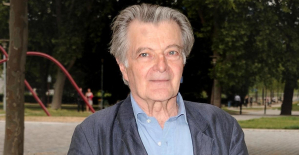The Nazi henchmen came early in the morning. The Haag couple were awakened from their sleep at around five o'clock, SA men were standing in front of the door with "storm straps under their chins, revolvers, rubber truncheons". They tore open boxes, threw out clothes, turned over drawers, ransacked desks.
“All very quickly, ruthlessly, with a repulsive zeal and obvious lust. We are by no means strangers to them, they know us and we know them, they are adults, fellow citizens, neighbors.” This is how the communist Lina Haag described her husband’s arrest after the war on February 10, 1933, a few days after Hitler took power. The former KPD politician Alfred Haag was initially imprisoned in the Oberer Kuhberg concentration camp in Ulm.
From the spring of 1933, tens of thousands felt the same way as The Hague. The working group “Memorial Sites at Sites of Former Concentration Camps” is now commemorating this “start of terror” by the Nazis and the establishment of the first concentration camps in an exhibition that is being shown at several locations nationwide, sometimes at the same time. For the first time, a broader public can get an idea of the overall history of the early camps. 15 of these camps are commemorated in the memorials that are part of the exhibition. They form the starting point and are exemplary for the more than 90 early concentration camps in the German Reich. The exhibition makes it clear that visible violence was a key means for the Nazis to consolidate their power.
The Reichstag fire provided the new rulers with a welcome excuse to pursue political opponents and further intensify terror. The "Emergency Ordinance for the Protection of People and State" of February 28, 1933 overrode essential basic rights of the Weimar Constitution; it formed the legal basis for the introduction of "protective custody" and the establishment of the first concentration camps.
Police and judicial prisons were soon completely overcrowded by the mass arrests. In many places, the cellars of SA meeting rooms served as temporary places of detention, along with barracks, workhouses and prisons, as well as empty factories and other buildings.
Many of the early concentration camps were set up in the middle of cities or on the outskirts - in public. Local residents could (and should) see or hear what was going on in the camps as an intimidation. The press, which was quickly brought into line, reported on the concentration camps and presented the places of detention as “education camps”. But reports by released prisoners about the inhumane conditions soon made the rounds.
The first concentration camps were mostly set up on the initiative of the SA, SS or local state authorities. In the early phase, different actors competed for responsibility for administration, management and security. The guards consisted of members of the SS, SA and the nationalist veterans' association Stahlhelm, who often exacted bloody revenge on opponents from the street fighting era who were now imprisoned.
Opponents of the regime were detained without charge or evidence. The judiciary had little access, the camps were practically unlawful areas. SA and SS men were given far-reaching powers to pursue and mistreat political opponents. In Prussia, in February 1933, Hitler's second man Hermann Göring officially appointed the SA, SS and some Stahlhelm members as "auxiliary police". There were raids and arrests throughout the Reich, often on the open street. In 1933, the SA, SS and the political police that had been taken over (the Gestapo in Prussia from March 1933) abducted tens of thousands – the organizers of the exhibition assume there were more than 80,000 people, some estimates even amount to up to 200,000.
The inmates were constantly exposed to violence and humiliation, which began with sadistic "reception rituals". These made the arriving men (initially only men were affected) aware of their powerlessness. A former prisoner of the Moringen concentration camp described it as follows after the end of the war: "Even the new arrivals were given a 'warm' welcome. Greeted with insults like 'criminal, scoundrel', they had to walk from the gate to the so-called cell building in the courtyard of the Landeswerkhaus through a trellis of SS men, who hit them with sticks and whips."
The henchmen frequently harassed prisoners of Jewish origin and well-known politicians. Walter Lembcke, a former prisoner of the Esterwegen concentration camp, described the humiliations to which the former SPD member of the Reichstag, Julius Leber, was subjected after 1945: “He had neither a bed nor a place to sit in his cell. The cell was darkened day and night. When the cell door was opened, he had to position himself with his hands and feet touching the floor opposite the door and, while barking and yapping, imitated dog noises. In the morning he had to walk on all fours to the latrine, pushed by SS Unterscharführer Brumm, Karl.”
How far they went depended, among other things, on the respective camp commandant and the composition of the guards. Fatal abuse and targeted murders were not uncommon.
After the wave of violence and arrests in the first few months, the Nazi authorities closed many of the torture sites and concentration camps again by the end of 1933. The persecution of the political opposition and groups stigmatized by the Nazis should be directed into controlled channels. In addition, from 1934 the SS often took over sole control of the camps; this was accompanied by a further tightening of prison conditions. The SS standardized the training of the guards and the leadership.
New, significantly larger barrack camps were built from 1936, for example in Sachsenhausen north of Berlin and on the Ettersberg near Weimar. The few remaining concentration camps from the early days were dissolved with a few exceptions. But the administrative practices and training principles tried out there formed the basis for the following crimes: Some of the former commanders and guards moved to the larger concentration camps, some later to the extermination camps on German-occupied Polish soil.
The early prisoners were released or transferred to larger concentration camps. The former KPD politician Alfred Haag, for example, came from the Oberer Kuhberg concentration camp in Ulm in 1935 to the Dachau concentration camp and then to Mauthausen in 1939. His wife Lina was able to obtain his release at the beginning of February 1940. He died in Munich in 1982.
After his imprisonment in Esterwegen concentration camp, Julius Leber was held in Sachsenhausen concentration camp until 1937. In 1944 the resistance fighter was arrested again and executed on January 5, 1945 in what was then the Berlin-Plötzensee prison.
The exhibition “Prelude to Terror. Early Concentration Camps under National Socialism” will be shown nationwide in several copies, some at the same time, including a show in the Berlin “Topography of Terror” (there until March 28). More information at www.auftakt-des-terrors.de.
You can also find "World History" on Facebook. We are happy about a like.

 His body naturally produces alcohol, he is acquitted after a drunk driving conviction
His body naturally produces alcohol, he is acquitted after a drunk driving conviction Who is David Pecker, the first key witness in Donald Trump's trial?
Who is David Pecker, the first key witness in Donald Trump's trial? What does the law on the expulsion of migrants to Rwanda adopted by the British Parliament contain?
What does the law on the expulsion of migrants to Rwanda adopted by the British Parliament contain? The shadow of Chinese espionage hangs over Westminster
The shadow of Chinese espionage hangs over Westminster Parvovirus alert, the “fifth disease” of children which has already caused the death of five babies in 2024
Parvovirus alert, the “fifth disease” of children which has already caused the death of five babies in 2024 Colorectal cancer: what to watch out for in those under 50
Colorectal cancer: what to watch out for in those under 50 H5N1 virus: traces detected in pasteurized milk in the United States
H5N1 virus: traces detected in pasteurized milk in the United States What High Blood Pressure Does to Your Body (And Why It Should Be Treated)
What High Blood Pressure Does to Your Body (And Why It Should Be Treated) “I’m interested in knowing where the money that the State takes from me goes”: Bruno Le Maire’s strange pay slip sparks controversy
“I’m interested in knowing where the money that the State takes from me goes”: Bruno Le Maire’s strange pay slip sparks controversy Despite the lifting of the controllers' strike, massive flight cancellations planned for Thursday, April 25
Despite the lifting of the controllers' strike, massive flight cancellations planned for Thursday, April 25 The right deplores a “dismal agreement” on the end of careers at the SNCF
The right deplores a “dismal agreement” on the end of careers at the SNCF The United States pushes TikTok towards the exit
The United States pushes TikTok towards the exit Saturday is independent bookstore celebration
Saturday is independent bookstore celebration In Paris as in Marseille, the Flames ceremony opens to fans of rap and hip-hop
In Paris as in Marseille, the Flames ceremony opens to fans of rap and hip-hop Sale of the century for a mysterious painting by Klimt, in Austria
Sale of the century for a mysterious painting by Klimt, in Austria Philippe Laudenbach, actor with more than a hundred supporting roles, died at 88
Philippe Laudenbach, actor with more than a hundred supporting roles, died at 88 Skoda Kodiaq 2024: a 'beast' plug-in hybrid SUV
Skoda Kodiaq 2024: a 'beast' plug-in hybrid SUV Tesla launches a new Model Y with 600 km of autonomy at a "more accessible price"
Tesla launches a new Model Y with 600 km of autonomy at a "more accessible price" The 10 best-selling cars in March 2024 in Spain: sales fall due to Easter
The 10 best-selling cars in March 2024 in Spain: sales fall due to Easter A private jet company buys more than 100 flying cars
A private jet company buys more than 100 flying cars This is how housing prices have changed in Spain in the last decade
This is how housing prices have changed in Spain in the last decade The home mortgage firm drops 10% in January and interest soars to 3.46%
The home mortgage firm drops 10% in January and interest soars to 3.46% The jewel of the Rocío de Nagüeles urbanization: a dream villa in Marbella
The jewel of the Rocío de Nagüeles urbanization: a dream villa in Marbella Rental prices grow by 7.3% in February: where does it go up and where does it go down?
Rental prices grow by 7.3% in February: where does it go up and where does it go down? Sale of Biogaran: The Republicans write to Emmanuel Macron
Sale of Biogaran: The Republicans write to Emmanuel Macron Europeans: “All those who claim that we don’t need Europe are liars”, criticizes Bayrou
Europeans: “All those who claim that we don’t need Europe are liars”, criticizes Bayrou With the promise of a “real burst of authority”, Gabriel Attal provokes the ire of the opposition
With the promise of a “real burst of authority”, Gabriel Attal provokes the ire of the opposition Europeans: the schedule of debates to follow between now and June 9
Europeans: the schedule of debates to follow between now and June 9 These French cities that will boycott the World Cup in Qatar
These French cities that will boycott the World Cup in Qatar Montpellier-Nantes: at what time and on which channel to watch the Ligue 1 match?
Montpellier-Nantes: at what time and on which channel to watch the Ligue 1 match? Ligue 1: Luis Enrique leaves many PSG players to rest in Lorient
Ligue 1: Luis Enrique leaves many PSG players to rest in Lorient Football: Deschamps, Drogba, Desailly... Beautiful people with Emmanuel Macron to play with the Variétés
Football: Deschamps, Drogba, Desailly... Beautiful people with Emmanuel Macron to play with the Variétés Football: “the referee was bought”, Guy Roux’s anecdote about a European Cup match… with watches and rubies
Football: “the referee was bought”, Guy Roux’s anecdote about a European Cup match… with watches and rubies


















